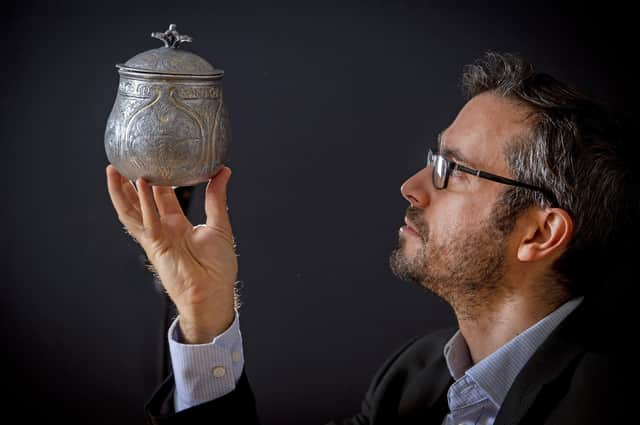Galloway Hoard illuminates past 'power and wealth' of area as it returns home


Items from the hoard are now on show at Kirkcudbright Galleries, Kirkcudbright, until July as part of an arrangement with National Museums Scotland.
Described as one of the most important archaeological finds of the century, the collection of silver, gold, jewels and textiles was buried around 900AD on land which may have been an early church site.
Advertisement
Hide AdAdvertisement
Hide AdDr Adrian Maldonado, researcher of the Galloway Hoard at National Museums Scotland, said: “The Galloway Hoard reflects the story of Kirkcudbrightshire. This is the story of the wealth and the power of this area 1,000 years ago.”
Dr Maldonado said Galloway – then part of the Anglo Saxon kingdom of Northumbria – was a place “buzzing with activity” around the time, with rivers and sea connecting the area to the world.
He said: “If you were near a good harbour or navigable river you were actually in the best possible place. You can get to Ireland, to the Isle of Man, to England. You are talking about being at the centre, rather than the edge.
“From here, you have access to the wider world.”
Whithorn was one of four major Bishop’s seats of Northumbria, with exotic wine and glass brought here for hundreds of years.
“It becomes this really famous place a couple of generations before the first Viking raid,” he added.
Dr Maldonado said, while it was not known if Vikings raided Whithorn, like they had Lindisfarne and Iona, excavations show there was large fire at the church around 850 AD.
“You can’t really tie that together with the Vikings but it is around the right time, around 850, so there might be a link,” he added.
At least some of the silver in the hoard came from a church, Dr Maldonado said.
Advertisement
Hide AdAdvertisement
Hide AdHe added: "The more you look at the Galloway Hoard, the less Viking it looks.
"We know that items within it contain runic inscriptions, but the big story was they turned out to be Anglo Saxon inscriptions, not Norse.
"Whoever was at the church or settlement where the hoard was deposited was Northumbrian. It was deposited by local folk . This is the wealth of local people and the church.”
The hoard may have been buried for safekeeping or as a sacrifice.
He said the silver-gilt vessel may have come from Central Asia and, in a Christian context, was likely used to carry consecrated bread, given it could only touch silver or gold. Later, it was buried wrapped in silk.
"The silk is very rare and there is very little evidence of use of silk in Scotland.
"But there is a letter of 790 from a churchman of the Carolingian court who is writing to the Bishop of Whithorn. He writes of sending a silk cloth for the altar.”
Arm rings, like those worn by Vikings and developed around the Irish Sea, feature among the hoard and may have been acquired by local people, perhaps through trading or raiding.
Advertisement
Hide AdAdvertisement
Hide AdDr Maldonado said: "Perhaps Anglo-Saxons, Britons, Picts and Scots are more involved in the Viking age economy than we thought. The Vikings must have been mingling and trading with the locals, as well as raiding.”
